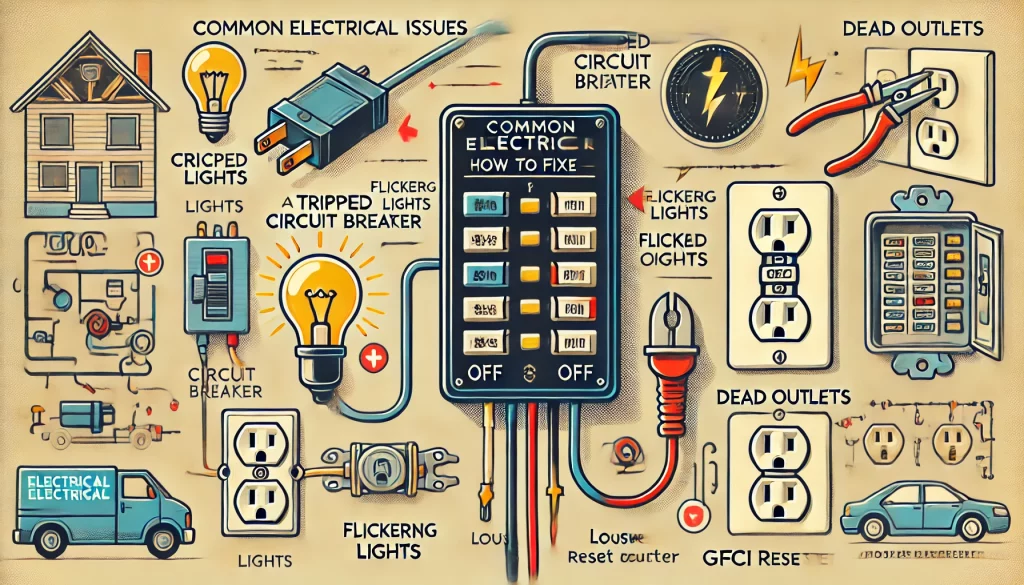Encountering electrical issues is a common problem for homeowners, renters, and even businesses. These issues can range from annoying flickering lights to potentially dangerous sparking outlets. Knowing how to identify and fix these problems can save you time, money, and ensure the safety of your property. In this guide, we’ll cover the most common electrical problems and provide step-by-step solutions.

1. Tripped Circuit Breakers
Why Circuit Breakers Trip:
A tripped circuit breaker occurs when too much electrical current is drawn from a single circuit. This usually happens when too many high-energy devices are plugged in simultaneously, such as space heaters, microwaves, or kitchen appliances.
How to Fix a Tripped Circuit Breaker:
- Locate your home’s breaker panel (often in the garage or basement).
- Find the breaker in the “off” position or in the middle position.
- Reset the breaker by flipping it fully to the “off” position and then back to “on.”
Pro Tip: Distribute your devices across different circuits and avoid overloading outlets. If your circuit breaker trips often, it may indicate an underlying electrical issue that requires professional attention.
2. Flickering Lights
Causes of Flickering Lights:
Flickering lights can be caused by a range of issues, including loose bulbs, faulty light fixtures, or electrical wiring problems. Flickering can also signal larger electrical issues, such as voltage fluctuations or overloaded circuits.
How to Fix Flickering Lights:
- Tighten the light bulb to ensure it’s securely screwed into the socket.
- If the flickering continues, try replacing the bulb with a new one.
- Inspect the light fixture for loose wiring (turn off power before checking wiring).
Pro Tip: If flickering lights persist across multiple fixtures, it’s best to call a licensed electrician to inspect for wiring or circuit issues.
3. Dead Outlets
Why an Outlet Stops Working:
A dead outlet may be caused by a tripped breaker, a loose wire, or a faulty outlet receptacle. Dead outlets can disrupt your household’s electrical needs and may also pose a safety risk if ignored.
How to Fix a Dead Outlet:
- Check your circuit breaker to see if the outlet’s circuit has tripped.
- Plug another device into the outlet to ensure it’s not the device itself.
- Turn off the power at the breaker panel and inspect the outlet wiring.
Pro Tip: Regularly check outlets in high-use areas like kitchens and living rooms for wear and tear. If you’re unsure about handling electrical repairs, contact a professional electrician.
4. Frequent Light Bulb Burnouts
Why Bulbs Burn Out Quickly:
If your light bulbs keep burning out, it may be due to the use of incorrect wattage, poor-quality bulbs, or issues with the light fixture. Sometimes, an electrical issue like fluctuating voltage can also cause frequent bulb burnouts.
How to Fix Frequent Bulb Burnouts:
- Ensure you’re using bulbs with the correct wattage for your fixtures.
- Switch to energy-efficient LED bulbs that last longer and reduce energy consumption.
- If the problem continues, the fixture or the electrical wiring may need inspection by a professional.
Pro Tip: Consider using LED bulbs to lower energy costs and avoid frequent replacements.
5. Sparking Outlets or Switches
Why Outlets Spark:
A sparking outlet can be a sign of a serious electrical issue, like short-circuiting or damaged wiring. While small sparks may sometimes be normal, consistent sparking is a red flag for potential fire hazards.
How to Fix Sparking Outlets:
- Unplug any appliances from the sparking outlet immediately.
- Turn off the power at the circuit breaker before inspecting the outlet.
- If you notice blackened or burnt wires, contact a professional electrician.
Pro Tip: Avoid overloading outlets, and always replace faulty outlets promptly to prevent electrical fires.
6. High Electricity Bills
Why Electricity Bills Increase:
A sudden increase in your electricity bill could point to energy inefficiency or hidden electrical issues in your home. Older appliances, faulty wiring, or even undetected energy leaks may contribute to higher energy consumption.
How to Fix High Electricity Bills:
- Conduct a home energy audit to identify areas of high electricity usage.
- Replace old, energy-consuming appliances with energy-efficient models.
- Switch to LED lighting and consider installing smart thermostats to optimize your energy usage.
Pro Tip: Monitoring your energy consumption regularly can help you catch inefficiencies early, lowering your monthly bills.
Conclusion
Addressing these common electrical issues promptly not only enhances the safety of your home but also improves energy efficiency. Some problems, like resetting a tripped breaker or changing a light bulb, can be done safely by homeowners. However, for more complex issues like faulty wiring or sparking outlets, it’s always best to consult a licensed electrician.
For reliable electrical services or further assistance with troubleshooting, contact Target Electrician. Whether you’re dealing with flickering lights, dead outlets, or persistent electrical issues, we’ve got you covered!
Additional SEO Optimizations:
- Keywords: “common electrical issues,” “fixing circuit breakers,” “flickering lights,” “dead outlets,” “electrical troubleshooting,” “residential electrician,” “energy-efficient lighting.”
- Headings and Subheadings: Proper use of H1 for the main title and H2 for subheadings helps Google understand the post structure.
- Internal Links: In future blog posts, you can link related topics such as energy efficiency tips or choosing the right electrician to improve SEO rankings.
- Meta Tags and Alt Texts for Images: If you include images, make sure to add relevant alt texts like “circuit breaker troubleshooting” or “flickering light repair.”
This version improves SEO by focusing on clear, actionable steps, utilizing keywords, and addressing common user search intents.
